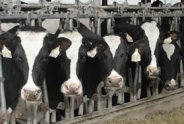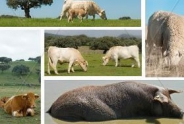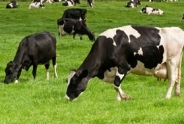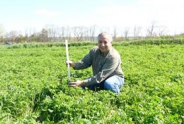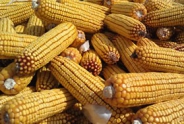**CANCELLED ** FARM Updates & COW$ - New Tools for Improving Individual Cow and Herd Profitability
Event Details
Date
August 12, 2024
Time
10 - 12 pm
Location
Walnut Ridge Dairy
100 Brown Hill Rd
Lansing, NY 14882
Host
South Central New York Dairy & Field CropsDonette J Griffith
6073912662
email Donette J Griffith
FARM Updates & COW$ - New Tools for Improving Individual Cow and Herd Profitability
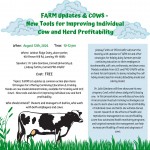
FARM Updates & COW$ - New Tools for Improving Individual Cow and Herd Profitability
When: August 12th, 2024
Time: 10-12 pm
Where: Walnut Ridge Dairy, above parlor, 100 Brown Hill Rd, Lansing, NY 14882
Speakers: Dr Julio Giordano, Cornell University & Lindsay Ferlito, Cornell PRO-DAIRY
Cost: FREE
Topics:
FARM 5.0 updates & common action plan items
Strategies for offering Continuing Education & training
Hands-on cow model demonstrations, available for training with CCE
Cow$ - New tools and data for improving individual cow and herd profitability
Who should attend? Owners and managers of dairies, who work with both employees and cows
Lindsay Ferlito of PRO-DAIRY will start the meeting with updates to FARM 5.0 and offer strategies for helping dairy farmers provide continuing education to their employees in stockmanship, calf care, euthanasia, and down cows. Models available from CCE and PRO-DAIRY will be on hand for participants to demo, including the calf tubing model, injection model, disbudding model and calving model.
Dr. Julio Giordano will then showcase his new program, Cow$, which shows daily profit/loss by cow. In this presentation, we will discuss how data from precision livestock farming technologies can be used to learn about and improve the profitability of individual cows and herds. We will also discuss recent research on the effects of health and reproductive management on cow profitability. Learn how automated health monitoring programs and targeted reproductive management can help increase profitability of herds and subgroups of cows.
Upcoming Events
Labor Road Show IX
December 1, 2025
The Roadshow delivers essential updates on labor law, regulations, and workforce best practices—tailored for farm owners, managers, and ag service providers. Sessions also focus on practical strategies to boost communication, strengthen retention, and build a positive workplace culture.
Winter Bale Grazing Pasture Walk
January 10, 2026
Truxton, NY
Join us for the second Bale Grazing Winter Pasture Walk!
Have you heard about or seen bale grazing and wondered if it would work for you?
Do you want to learn the nuances and logistical context for implementing this regenerative practice?
Are you interested in seeing the impacts of bale grazing on land and animals from a practicing farmer?
If you answered Yes to any question, The Northeast Region National Grazing Lands Coalition, the Cornell Cooperative Extension Hillside Farms are teaming up to showcase our Second Bale Grazing Winter Pasture Walk!
Announcements
USDA Contract Freezes and Terminations: Legal Action Steps for Farmers
For Farmers with Signed EQIP and CSP ContractsThis resource is written for farmers and ranchers nationwide who have a signed contract with USDA NRCS under the EQIP or CSP program for environmental improvements but have concerns that their contract is frozen, under review, or terminated, and who are uncertain of their rights to receive reimbursement as well as their ongoing obligations under the signed contract.
Version: 1.0
Issue date: Feb 28, 2025
A downloadable factsheet is available at our BUSINESS tab on the top of our webpage.
Additional Information: www.farmcommons.org
USDA Contract Freezes: Filing an NAD Appeal or Demand Letter
This resource is written for farmers and ranchers nationwide who have a signed contract with USDA NRCS under the EQIP or CSP program for environmental improvements and want more information on the mechanics of filing a National Appeals Division (NAD) appeal. This resource includes sample letters.
USDA NAD Appeal https://www.usda.gov/about-usda/general-information/staff-offices/office-hearings-and-appeals/national-appeals-division/nad-appeals
Farm Participants Needed for Bale Grazing Grant!
Information on the Project:- Approximately 10 acres total needed to bale graze two different bale densities
- "Core" farms will graze two winters, "Demo" farms will graze one winter.
- Payments for both "Core" farms and "Demo" farms
- Baseline soil sampling by bale grazing team
- Forage measurements in early season by bale grazing team
- Late season clipping if residual not trampled down by farm
Cornell Cow Convos - New Podcast
On-going podcast, New episodes released on the last Thursday of the month.Guest speakers, CCE Dairy Specialists.
Housed on Soundcloud Channel is CCE Dairy Educators
- Preventative healthcare for cows
- The trend of beef on dairy
- What to look forward to in the new year for dairy
- Socially grouping or pair-housing calves
2018 Drug Residue Prevention Manual
For more than 30 years, the U.S. dairy industry has focused educational efforts on the judicious use of antibiotics through the annual publication of a Best Practices Manual. The 2018 edition of the National Dairy FARM Program: Farmers Assuring Responsible Management? Milk and Dairy Beef Drug Residue Prevention Manual is the primary educational tool for dairy farm managers throughout the country on the judicious and responsible use of antibiotics, including avoidance of drug residues in milk and meat.The manual is a quick resource to review those antibiotics approved for dairy animals and can also be used as an educational tool and resource for farm managers as they develop on-farm best management practices necessary to avoid milk and meat residues. Visit the Manual and Form Library to download copies of this important tool!
Follow us on Facebook
The team updates our facebook page frequently - follow us to be updated on our events, see some fun videos and get local area updates!facebook.com/SCNYDairyandFieldCropsTeam
NYSERDA Agriculture Energy Audit Program
NYSERDA offers energy audits to help eligible farms and on-farm producers identify ways to save energy and money on utility bills. Reports include recommendations for energy efficiency measures.For more information and the NYSERDA Agriculture Energy Audit Program Application click here

